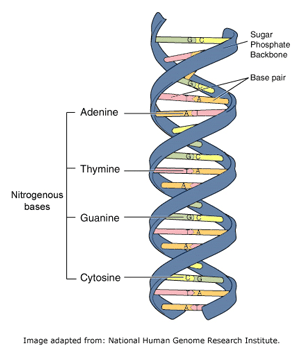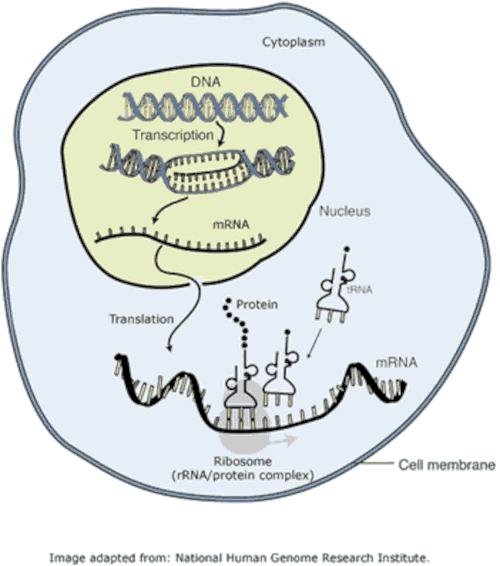Virtual Genetics Education Centre
Gene regulation and expression for schools and colleges
Gene expression
Your genes contain a code, a code for making chemicals called proteins. This code, the genetic code, lies in the sequence of the bases along one strand of the the DNA molecule. There are four bases: adenine (A), thymine (T), guanine (G) and cytosine (C). Adenine always pairs with thymine; and guanine always pairs with cytosine: A-T and G-C.
The DNA double helix, showing base pairs. codons and amino acids.
You can think of the genetic code as a language. Each group of three bases or 'letters' forms a 'word' called a codon. Each codon specifies one amino acid, and proteins are made from long chains of amino acids. There are also codons that mark the start and end of the gene.
But how is the code actually read? There are two stages in using the genetic code to make a protein.
- Transcription. The two strands of the helix separate and the sequence of bases in one strand - the template strand - is used to make a special 'messenger' chemical called messenger RNA (mRNA).
The template strand that codes for the protein makes mRNA using the base-pairing rules. There is one difference, however: thymine (T) is replaced with a new base, uracil (U).
- Translation. In the second stage, the mRNA molecule is used as a template to build a protein. A structure called a ribosome 'reads' the codons as it moves along the mRNA molecule. The ribosome is made from protein and another sort of RNA, ribosomal RNA (rRNA). Other RNA molecules, called transfer RNA (tRNA), bind to the ribosome carrying the amino acid that matches each codon. The end result is a chain of amino acids - a protein.

Changes in the genetic code are known as mutations and can have many consequences. You can read more about this on the 'Genetics, mutation and cancer' page.
Gene regulation

Almost all the cells in your body contain two copies of every gene. But your body contains many different sorts of cells, from muscle cells that help you move to cells in your eye that help you see. The cells are different because they make different proteins.
An example of a protein. Actin is formed from a number of smaller protein subunits and plays an important part in the contraction of muscle cells.
Your body can make different sorts of cells using the same set of genes because it can control which genes are used to make proteins. In any cell at any time, some genes are switched on and some genes are switched off. A heart cell will make the proteins needed for a heart cell; a liver cell will make the proteins needed for a liver cell.
Genes are switched on and off by other proteins called transcription factors, which stick to special control sites in the DNA at the start of a gene. These transcription factors are coded for by other genes - so genes are often controlled by the activities of other genes. Scientists think that maybe as much as 10 per cent of our genes are responsible for producing transcription factors.